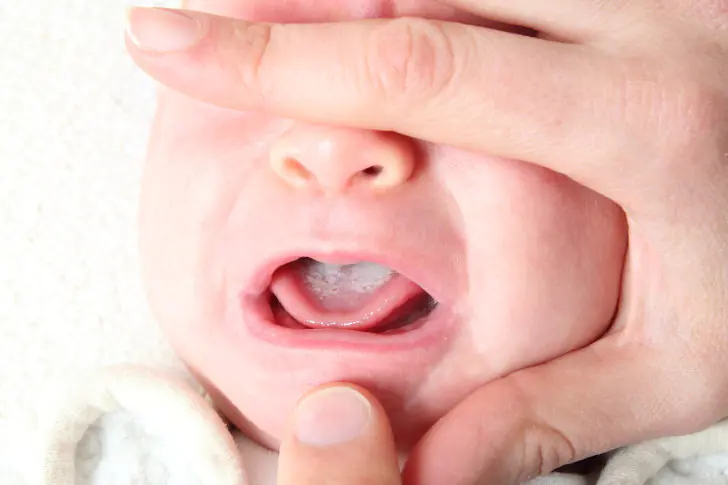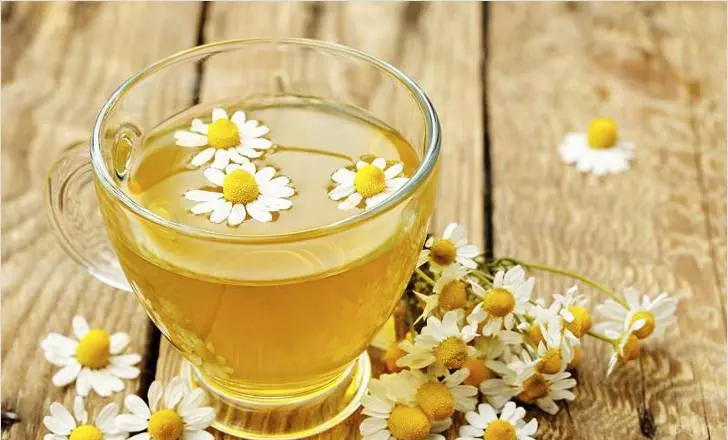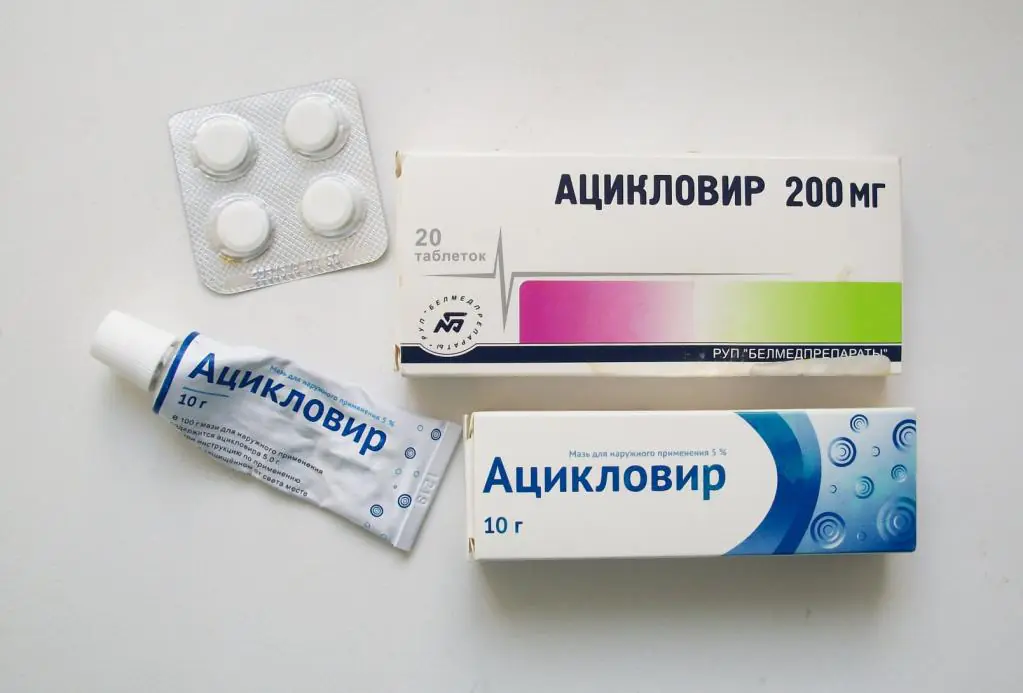Quite often, pediatricians observe white pimples on the oral mucosa in a child. Such rashes signal an existing disease or its development. In order to prescribe the correct treatment, it is necessary to find out the cause of their appearance. These can be general or local diseases, various injuries.
Local diseases
The cause of white rashes is stomatitis, which manifests itself in different forms:
- Aphthous - the cause of its appearance has not been identified; it occurs in acute, chronic and recurrent forms. The disease is characterized by the appearance of many aphthae (ulcers) of irregular shape, leading to difficulties in eating. Healing is long and sometimes lasts several months.
- Candidiasis - most often found in newborns. The white pimples in the mouth gradually merge, and the entire cavity becomes covered with a whitish coating.
- Herpetic - unlike previous forms, the sores are pinkish or red in color and have a watery structure. In addition to the oral cavity, the lips are also affected. It occurs in children from one and a half to three years old. The mild form can be treated at home, while the severe form can be treated in a hospital.
- Allergic – provoked by allergens: plant pollen, household dust, animal hair, etc. By removing the source of the allergy, stomatitis stops.
- Bacterial – develops due to the penetration of pathogenic microflora (staphylococci, streptococci) into existing wounds in the oral cavity.
Injuries
White pimples in a child’s mouth can be caused by various injuries:
- Strong bite of the tongue with teeth, which provoked an inflammatory process and, as a result, the appearance of white ulcers.
- Damage to the mucous membrane caused by hard bristles during oral hygiene.
- Injury from sharp edges of teeth due to violations committed during the installation of filling material.
- Incorrectly selected braces.
- Injuries caused during dental treatment due to careless handling of dental instruments.
Systemic pathologies
What causes white pimples in a child's mouth? The following diseases can trigger their appearance:
- Pulmonary tuberculosis - affects the mucous membrane of the oral cavity. Sores of a loose structure with uneven edges form on it.
- Syphilis – boils may appear in the oral cavity.
- Necrotizing gingivostomatitis - ulcers appear on the mucous layer of the oral cavity, which are covered with a greenish coating.
- HIV infection - the lesion affects the gums.
In addition, the following pathologies cause the formation of pimples in a child’s mouth:
- dysbacteriosis;
- atonic colitis;
- heart failure in the stage of decompensation;
- hypothyroidism;
- diabetes mellitus.
Symptoms
In addition to white pimples in a child’s mouth, he may experience the following signs that parents should pay attention to:
- temperature increase;
- restless, capricious condition of the baby caused by dryness or burning in the mouth;
- refusal to eat;
- enlarged lymph nodes;
- bad breath.
If such symptoms are detected, it is advisable to examine the oral cavity and consult a doctor.
Some treatment features
Therapy should be aimed at eliminating the root cause and alleviating the condition of the little patient. In case of mechanical damage to the oral mucosa, the wound surface is treated, having previously removed the foreign object. If chronic pathologies are the cause of white pimples in a child’s mouth, comprehensive treatment is recommended using medications from different pharmacological groups:
- "Arbidol", "Acyclovir" - has an antiviral and anti-inflammatory effect.
- Antiseptics are used for irrigation and rinsing.
- Antipyretics – to relieve fever.
- Vitamin complexes - to strengthen the immune system.
- Antibiotics do an excellent job of killing pathogens.

A prerequisite for successful treatment is maintaining oral hygiene and drinking plenty of fluids.
Causes of thrush in newborns
This fungal disease often occurs in weak and premature babies and affects the mucous membranes of the tongue and oral cavity. He can become infected from his mother or another person who has been in contact with him. The pathogen enters the body of a small person through a pacifier or other objects that the baby puts into the mouth. Infection during the period of delivery occurs if the mother has pathogenic species of fungi in the vagina. Frequent regurgitation also provokes the occurrence of thrush in the mouth of a baby, since during this process stomach contents accumulate in the oral cavity, which has an acidic environment, which is a fertile environment for the proliferation of fungi. Long-term antibacterial therapy is another provocative factor in the development of the disease.
Symptoms of thrush
The appearance of small whitish spots on the tongue, cheeks, gums and mucous membrane of the palate are among the first signs of the disease. After a short period of time, they increase in size and merge, forming a coating called curd-like. Then its color changes to yellowish or gray. It is not possible to remove plaque with a spatula. Thrush in a baby's mouth causes anxiety and moodiness. It hurts for the baby to breastfeed. In addition, the baby has other manifestations:
- reddish rash in the diaper area;
- small weight gain;
- the appearance of clicking sounds during feeding;
- saliva acquires a whitish sheen;
- breast refusal;
- increased salivation.

Delayed diagnosis and lack of treatment is fraught with serious complications: a grayish-white film spreads throughout the body, covering the esophagus and upper respiratory tract. And if it gets into the bloodstream, there is a high probability of developing a septic condition.
How to treat oral thrush in a baby?
The following drugs are used for treatment:
- Baking soda. Prepare a two or six percent solution and lubricate or irrigate the oral cavity with it. This manipulation must be performed several times a day.
- Sodium tetraborate in glycerin. Apply the solution to the affected areas no more than three times a day for a week.
- Gentian violet - this drug is used to lubricate the baby’s oral mucosa.
- Nystatin. Two tablets are dissolved in fresh milk, of which 2 ml are taken. The prepared mixture is lubricated with the oral mucosa several times a day.
When alternating means, their effectiveness increases. The existing plaque will gradually disappear without causing pain or discomfort.
Prevention of thrush
You now know how to treat thrush in the mouth of an infant, and below we will consider preventive measures, the implementation and observance of which will protect the baby from such a nuisance as thrush:
- Creation of good sanitary and hygienic conditions.
- Compliance with hygiene rules by persons caring for a newborn.
- Regularly sterilize baby bottles, nipples, spoons and other utensils.
- Treat toys daily with approved disinfectants.
- Timely examination of the mother for the presence of fungus and completion of the full course of treatment if it is detected.
Pimples on a child's tongue
In a baby, the mucous membrane of the tongue is very sensitive and thin, so any damage to it provokes inflammation, which results in various rashes. In addition, pimples can appear under certain pathological conditions.

A rash on the tongue is not dangerous, but it causes a lot of inconvenience: it creates discomfort and prevents the child from eating. Therefore, first of all, it is necessary to eliminate the factors that caused this condition. These include:
- Thrush and candidiasis. The development of these diseases is possible due to the infant’s weak immunity. In this case, white pimples appear on the child’s palate and tongue, and then occupy almost the entire oral cavity, forming a curd-like coating.
- Injury to the tongue. At the age of three or more months, babies become inquisitive and quite active. They begin to taste everything, and along with objects or toys that they pull into their mouths, pathogenic microorganisms are introduced, and in addition, injury to the mucous layer is possible.
- Stomatitis. This disease causes discomfort in the form of pain and interferes with eating. White pimples are localized on the tip, side surfaces and in the area of the root of the tongue. Then they merge and ulcers form.
- Allergy. Its manifestations are different, including in the form of white pimples on the child’s tongue, which form on its surface. This phenomenon is typical for children under two years of age. Subsequently, the rashes affect the root, tip and sides of the tongue, as well as other parts of the oral cavity.
- Dysbacteriosis. A disturbance in the intestinal microflora caused by poor nutrition can cause inflammation of the mucous layer of the tongue, which is manifested by inflamed papillae resembling small pimples.
- Angina. A bacterial infection affects the tonsils and may affect the root of the tongue, where in addition to whitish pimples there is a purulent coating.
Treatment of pimples on the tongue
To eliminate white pimples in a child’s mouth, it is recommended to do the following:
- After each meal, rinse your mouth with an antiseptic liquid. The mucous membrane of the tongue is also treated with the same product.
- Eliminate from the child’s diet foods containing dyes, as well as foods that have an irritating effect: hot, salty.
- Do not squeeze pimples.
- Give your baby more fluids.
In addition, the doctor may recommend taking medications:
- “Solcoseryl”, “Metrogil denta” - to eliminate discomfort and relieve the inflammatory process.
- Antibiotics - for sore throat.
- Antifungal - for the treatment of thrush and candidiasis.

You can also use the remedies recommended by herbalists:
- decoctions of St. John's wort, eucalyptus, chamomile, sage;
- soda solution;
- sea buckthorn, peach or rosehip oil.
The above folk remedies are used for washing, rinsing and irrigating the oral cavity. Their use is permitted in the absence of allergic reactions to medicinal plant materials.
Prevention
The following precautions will help you avoid pimples on your tongue:
- It is advisable to teach your child to properly care for the oral cavity from an early age.
- Brush your teeth, tongue and gums every day, up to twice.
- Visit the pediatric dentist every six months.
- Do not allow your baby to put dirty toys or other objects in his mouth.
- The child's nutrition should be balanced.
- Strengthen the immune system from birth.
Causes of white rashes in the mouth of a baby
There are several reasons for this phenomenon:
- The appearance of pimples in the baby’s mouth may be a sign of stomatitis. The baby has whitish-grayish ulcers, bad breath, and fever.
- The next reason for the appearance of white pimples in a child’s mouth, as well as plaque on the tongue and gums, lies in a disease called thrush.
- Ulcers and white pimples on the tongue can signal dysbiosis or herpes.
- A small pimple on the gum can be an ordinary wen, and if it increases in size, then this is a sign of a more serious pathology.
- Pimples may appear before teething.
- A large abscess or cyst in the mouth also looks like a white pimple.
Thus, if you find a rash in your baby’s mouth, you should contact your pediatrician. He will diagnose the disease and prescribe appropriate treatment.
Stomatitis in a child
With this pathology, white pimples are concentrated in groups, the number of which increases over time. Further, they burst and form spots covered with a whitish and sometimes yellowish coating. The disease has several stages and occurs in both acute and chronic forms. Specific treatment for stomatitis depends on the pathogen that caused the disease. Thus, stomatitis caused by a virus is treated with Zovirax, Viferon, and Gerpevir. Let’s look at how to treat stomatitis in children’s mouths below. General recommendations:
- Give your baby more fluids.
- Carry out oral hygiene regularly.
- Eliminate sugar and sweets from your diet.
- Make sure your child maintains hygiene: washes his hands before eating, after visiting the toilet or going for a walk.
- Before giving a pacifier or pacifier to a child, pour boiling water over it.
- Use Panadol and Ibuprofen to reduce fever.
- For treating the mucous membrane, antiseptic liquids are indicated, for example, factory-made “Miramistin” or pharmaceutical - a solution of boric acid, furatsilin.
- Decoctions from medicinal plant materials have proven themselves to be excellent for irrigating and treating the oral cavity of infants: chamomile, calendula, sage.
- Lubricating white rashes with natural oils: sea buckthorn, linseed or peach.
- Painkillers: “Cholisal”, “Kalgel”, “Kamistad” should be used taking into account the instructions for medical use, since not all of them are approved for use in all age categories.
- Faster healing is stimulated by drugs such as Vinilin, Actovegin, Solcoseryl.
Possible complications
Taking good care of your child's oral cavity will help avoid serious complications. Parents need to remember that not every pimple or ulcer signals a serious pathology. The main reason for their appearance is damage to the oral mucosa. However, you should be wary of such things as frequent and painful inflammatory processes that bother the baby and provoke a rise in temperature. In these cases, stomatitis is a symptom:

Timely diagnosis and treatment minimize the negative consequences of the above diseases. So, complications of measles, for example, are pneumonia, otitis media and laryngitis, and tonsillitis – arthritis, pyelonephritis, rheumatism.
Conclusion
All parents have to deal with childhood illnesses. These include white pimples in a child’s mouth, which cause a lot of suffering and inconvenience for the baby. For a quick and high-quality cure, it is recommended to immediately visit a pediatrician and not self-medicate. In addition, breastfeeding should not be interrupted when the baby is ill. The most effective treatment is prevention, and the best prevention is regular visits to the dentist.
The phenomenon of a white pimple in the mouth is quite common. There is little pleasure in such a situation, since such formations are quite painful, especially during conversation, drinking or eating. For those who have no idea what pimples look like in the mouth, the photo below will help to get a general understanding. If a problem arises, this will give you the opportunity not to get confused and take all the necessary and correct measures.
Let's talk about why a pimple appears in the mouth in the first place. What diseases can it indicate, what methods of treating and preventing inflammation exist?
Pimple in the mouth: what does it mean?
So, what are pimples that appear in the mouth? This is inflammation of the oral mucosa (cheeks, lips, soft palate). This disease is collectively called “stomatitis”. Purulent acne in the mouth is also divided into several types, which depend on the causative agent of inflammation. Let us consider in a little more detail each of the possible variants of stomatitis, as well as some other reasons for the occurrence of such a nuisance.
Herpetic stomatitis
In this situation, the causative agent of the disease is the herpes virus. A pimple appears in the mouth: on the lip or cheek. Most cases of herpetic stomatitis occur in adolescents or young children.
In the mouth, a pimple looks like a small blister filled with liquid. It bursts quickly. As a result, a small painful ulcer with a white coating around its circumference appears in its place.
During this type of stomatitis, a slight increase in temperature is observed. In addition, you need to monitor the condition of the lymph nodes, as they may become enlarged.
Bacterial stomatitis
The causative agents of this type of disease are several bacteria. In most cases it is staphylococcus or streptococcus. Bacterial stomatitis can occur after a cold or sore throat, when the body spends a lot of energy on recovery.
Secondary signs of the disease are usually absent, only in some rare cases weakness and a slight increase in temperature may be observed.
With bacterial stomatitis, a pimple may appear in the mouth on the cheek, gums and mucous membranes of the lips. Such rashes do not cause much harm and disappear without a trace. The main thing in this situation is to prevent further growth of bacteria.
Fungal (candidal) stomatitis
This is the most common type of stomatitis. The causative agent of the disease is Candida fungus. It also causes thrush in women and men.
The main reason for the excessive proliferation of this type of fungus is a decrease in general or local immunity. This can happen, for example, due to improper use of antibiotics, which results in disturbances in the microflora of the body.
Fungal stomatitis begins with redness of the oral mucosa and the appearance of small pinpoint deposits on it. After this, an increase in the amount of plaque, swelling of the mucous membrane and the appearance of erosions are observed.
Under no circumstances should this disease be ignored, as if left untreated, it can spread throughout the gastrointestinal tract.
Herpangina
The causative agent of herpangina is an enterovirus, or more precisely, the coxsackie virus. Most often, the disease occurs among young children and is characterized by the appearance of a small rash on the tongue and walls of the cheeks.
In the mouth, a pimple (in the form of a small bubble with liquid) quickly bursts, and in its place a white coating appears, which is very difficult to remove. Herpangina may be accompanied by fever, as well as redness of the mucous membranes of the mouth and throat. The disease can cause a rash to appear on the child's arms and legs or cause constipation.
White pimples in the mouth and childhood infections
Children's infectious diseases such as chicken pox, rubella, measles, scarlet fever, mumps and whooping cough are accompanied by changes in the microflora in the mouth. At first the pimple appears alone, but soon a rash can be found on the inside of the cheek. After 2-3 days, papules can be detected, which are known as Filatov-Koplik spots. Their appearance confirms a diagnosis such as measles.
There is no need to treat these rashes, since the cause of their appearance is the presence of a serious illness. It needs to be eliminated first.
White pimples in the mouth due to other diseases
In adults, the appearance of pimples and ulcers on the oral mucosa may indicate the presence of such a terrible disease as lupus. It is characterized by disruptions in the immune system when the body fights itself.
Lupus ulcers are painful and heal very poorly. Only an experienced specialist can determine the disease and prescribe the necessary treatment. This is done by passing all the necessary tests.
The manifestations of lupus can be easily confused with secondary syphilis. The rash during both diseases is identical. Therefore, you should not be surprised if the doctor prescribes a blood test to detect syphilis. This must be done to be able to establish an accurate diagnosis.
Since we are talking about sexually transmitted diseases, with syphilis the rash is periodic - it appears, disappears after a while, and then comes back.
A pimple on the roof of the mouth can appear for several reasons:
- allergic reaction;
- presence of problems with immunity;
- mechanical damage to the mucous membrane (injection, scratch, etc.);
- getting into the oral cavity and developing any infection.
Depending on the type of disease, the necessary treatment methods are selected.
Treatment of acne in the mouth
First of all, it should be noted that in case of acne and rashes in the mouth, you should never self-medicate. Only an experienced specialist will be able to correctly identify the disease and prescribe the necessary therapy. The diagnosis in this case is made based on the results of an oral smear analysis.
As a rule, treatment is carried out with antibiotics and anti-inflammatory drugs. In cases where acne, rashes or ulcers cause very severe pain, the patient may be prescribed analgesics.
Local treatment, which is carried out in most cases, consists of rinsing the mouth. For these purposes, a soda solution can be used (dissolve a teaspoon of soda in a glass of warm boiled water), as well as infusions of useful medicinal plants: plantain, chamomile, calendula, sage. Young children can rinse their mouths with a weak solution of potassium permanganate or "Miromistin".
In the case of candidal stomatitis, antifungal drugs (Fluconazole, Nystatin, etc.) may be prescribed.
If acne and mouth ulcers appear, you should immediately review your menu and exclude citrus fruits from it for a while, as well as other fruits and juices that contain a lot of natural acid. This will help avoid irritation and pain. In addition, it is better to limit the intake of solid foods (chips, crackers, etc.), as they can damage the top layer of the ulcer, as a result of which it can increase in size.
Preventing acne in the mouth
The main way to prevent the appearance of inflammation in the form of purulent pimples and ulcers is to follow the rules of oral hygiene. Even if you have stomatitis, you should never stop brushing your teeth every day. If discomfort or pain occurs after using a paste or conditioner, it is worth replacing your usual products for a while with others that do not contain sodium lauryl sulfate and alcohol.
In addition, regular visits to the dentist are required, which will help to notice and eliminate possible problems in time: broken teeth, fallen parts of the filling, etc.
Certain foods that are not tolerated by the body individually can also trigger the appearance of purulent pimples in the mouth. What to do if you suspect that the appearance of stomatitis is associated with eating a certain food? There are two options: contact an allergist or solve the problem yourself. In the second case, it is recommended to keep a special “food diary” in which all the foods that were eaten will be entered. The disadvantage of this method is that detecting any pattern may require quite a lot of time.
Strengthening the immune system in every possible way deserves special attention. For example, you can start taking multivitamins, the lack of which provokes the onset of the disease.
In young children, the body is not yet strong enough, so they are more likely to suffer from infectious diseases than adults. It is important for parents to pay attention to all changes occurring in the child, paying special attention to skin rashes. They often make it possible to identify an incipient disease at an early stage. The mucous membranes instantly react to all negative influences with the appearance of acne and rashes.
Why do small pimples appear in a child’s mouth?
If pimples or a rash appear in the baby’s mouth, microbes (viruses, bacteria, etc.) can spread throughout the body, causing dysbiosis and other complications. Such manifestations are a sign of the onset of the disease, and the best solution is not to delay a visit to the doctor and get examined as quickly as possible.
Diseases of the oral mucosa
Rashes and pimples in a child’s mouth and throat are often the result of stomatitis. Inflammation of the mucous membrane is caused by viruses, bacteria or fungal infections. Children put everything they can reach into their mouths, so first of all it is necessary to exclude the possibility of infection. If infection has occurred, the doctor will determine the type of pathogenic flora and prescribe treatment.
White purulent pimples are symptoms of the following diseases:
- bacterial stomatitis;
- herpes;
- candidiasis (fungal infection).
White coating on the tongue appears due to serious conditions such as necrotizing gingivostomatitis, syphilis, HIV, and pulmonary tuberculosis. All of them are characterized, in addition to specific manifestations, by a decrease in the functions of the immune system, the presence of concomitant viral infections, and allergic reactions. Pimples, ulcers appear on the tongue and mucous membranes, bleeding and gum damage are possible. The child requires long-term systemic treatment under medical supervision.
However, disorders associated with general diseases are more common. Pathologies of the cardiovascular system, endocrine system disorders and malfunctions of the digestive organs can cause plaque and the appearance of pimples on the tongue:
Most of these conditions can be corrected in a timely manner and do not subsequently affect the child’s health. Look at the photo to see what white pimples in a child’s mouth look like (we recommend reading: white pimple on a baby’s gum: what are the causes of its appearance and how to eliminate it?).
Injuries to the mucosa
A rash on a child's tongue or pimples on the inside of the cheek can be caused not only by infection or disease, but also by injury. Babies bite their tongues or cheeks due to poor coordination and the fact that they are still learning to use their growing teeth. Inflammation occurs at the site of the wound and small ulcers and red pimples may appear. The mucous membrane is easily damaged by a hard toothbrush or incorrect actions when brushing your teeth. Ulcers appear due to burns of the mucous membrane by caustic chemicals.
Gums may be damaged by braces that are not suitable in configuration or size. Sores occur if the tongue touches the edge of a decaying tooth or a filling that requires correction. Baby teeth are easily damaged and must be carefully looked after. In all such cases, a dentist or orthodontist should provide assistance and prescribe treatment.
Various diseases
Periadenitis is characterized by the most severe course. This is a recurrent disease in which severe pain occurs and ulcers form - blood and lymph accumulate in them. The disease can last several months and requires serious treatment.
Aphthous stomatitis is also chronic. The pimples turn into abscesses; they appear in the mouth periodically and cause pain when eating and talking. Treatment can take from a week to several months, depending on the extent of the disease.
Herpetic stomatitis can be distinguished by the color of the rash - ulcers are characteristically red or pink. They are located on the tongue or lips and look like water bubbles. With proper treatment, they disappear within a week.
Candidal stomatitis most often affects infants. With this disease, the mucous membranes of the mouth and tongue are covered with a white coating and are easily injured. It is treated strictly in accordance with the doctor’s prescriptions.



